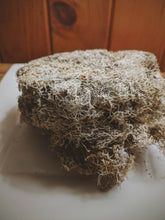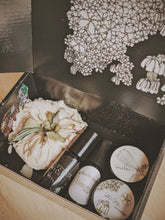
Oakmoss Soliflore ☽•☾ natural perfume.
a l c h e m y ☽•☾
Single note oak moss scent with in house extractions of wild mosses from my family's old growth forest. "Oakmoss." A staple note in perfumery, if not an ingredient. What is oakmoss? Well, it's not a moss for one, and it's not a single species, nor is it a plant. It's a lichen, or rather, it's many lichens. And it is found growing on lots of trees besides oak: fir, spruce, cedar, and pine, for example. See list below for a less than comprehensive index of the numerous species of lichens that can provide this iconic note. Bushy, foliose, and fruticose, as lichen, the sources of oakmoss rely upon mutualism-- which is defined as mutually beneficial symbiosis-- to create the composite organism that each one is, namely, "algae or cyanobacteria living among filaments of multiple fungi species" ("Lichen," Wikipedia). Usnea, Evernia, and Pseudevernia are the primary genuses of oakmoss. Around here, they are often found growing on dead or dying boreal trees like balsam fir and red, black, white, and Norway spruces. I usually find them on spruce trees, for whatever reason. Their whimsical appearance is reflected in their names: Old Man's Beard, Antler Lichen, Blood-spattered Beard Lichen (Vicente Aranda's oakmoss?). But they keep their perfume a secret, having practically no fragrance until they are unlocked via solvent. After being immersed, both the menstruum and the marc transform, coming out of the experience perfumed with "oakmoss."
Oakmoss, if it grows on oak trees, may produce an extract with traces of the cough suppressant elixir scent of oak wood. But if it grows on fir or spruce, the product may have jammy notes. Pine lichen can yield an oakmoss with turpentine, gasoline, and mineral spirits attributes. On Northern White Cedar (Thuja occidentalis), it will take on characteristics of this tree, which smells more like white sage than true cedar (Cedrus). If you want an ocean brine note cleansed of seaweed, sand fleas, ambergris, and fish, then "oakmoss" is your friend. For me, oakmoss is a cliff forest by the sea. It is windy, brown, but warm. It's a velvet dress, old books, and a banquet. It's the aroma of the sconces in Jean Cocteau's La Belle et la Bête and the dry, shadowless odor of topiary in L'Année dernière à Marienbad (dir. Alain Resnais).
Photos: mixed spruce, fir, and pine tree mosses collected from my family's old growth forest, post tincture; solid perfume in 5ml and 10ml black violet glass jars; liquid perfume in 5ml and 10ml black violet glass roller ball bottles.
r a w ☽•☾ m a t t e r
Wild Veil natural perfumes are composed by me, Abby, using homemade, wildcrafted and organic aromatics in Vermont. These include my handmade enfleurage, tinctures, enfleurage extraits, absolutes, resinoids and concretes, and floral waxes. I spend as much time growing plants and foraging as I do composing perfumes.
h o w ☽•☾ t o ☽•☾ w e a r
The best way to experience a natural perfume is to apply it to well-moisturized skin, without rubbing in (absorption only shortens the wear time of fragrance) and without scrubbing off. Natural perfumes are dynamic and take a minimum of 2 hours to reach their final stage, or dry down. Enjoy the alchemical changes as they unfold from the initial intensity of top notes, to the warmth of the heart, to the depth of lower base notes.
☽•☾ Wild Veil ☽•☾ alchemy between earth and ether ☽•☾
☽•☾ All aesthetic material copyright Abby Hinsman 2025 ☽•☾


















